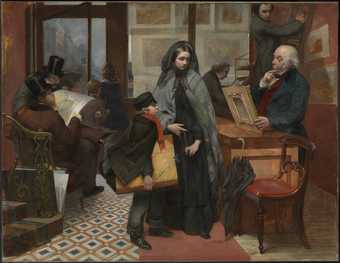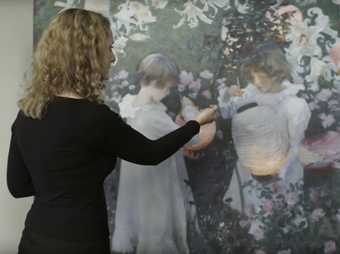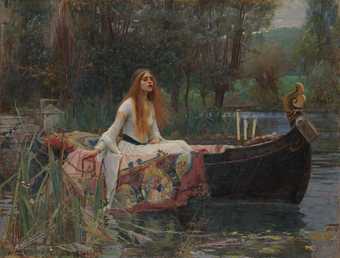This is The Lady of Shalott by John William Waterhouse.
Painted in 1888, it tells the story of a nameless woman who suffers from a curse. As we see the lady moving downstream in a boat, two low-flying swallows tell us that something ominous is happening. The lady is dying.
The Lady of Shalott is one of three paintings that Waterhouse based on a poem by Alfred Tennyson, set in the times of the legendary King Arthur and the medieval city of Camelot. The poem was a very popular subject for artists in Victorian Britain because of its theme of tragic love.
Forbidden to leave the tower, the Lady is only allowed to see the outside world through a mirror or else suffer an unnamed curse.
Waterhouse captured the poems first part in his 1915 painting I am Half-Sick of Shadows Said the Lady of Shalott. As the lady spends her days weaving a tapestry, we see the city of Camelot in the mirror's reflection along with two lovers enjoying life. Trapped in her tower, the lady longs for love.
'When the moon was overhead,
Came two young lovers lately wed,
'I am half sick of Shadows',
Said the Lady of Shalott.''
Curiously a red poppy appears in the reflection of the mirror but not in the foreground where it should be. Symbolizing eternal sleep, the poppy foreshadows the lady's impending doom. While weaving shuttles, that look like small wooden boats, predict the scenes to come.
Waterhouse told the next part of the poem in his 1894 painting The Lady of Shalott Looking at Lancelot. One day the lady sees an image in her mirror of the knight Lancelot riding towards Camelot.
He rode between the barley-sheaves,
The Sun came dazzling thro' the leaves,
and flam'd upon the brazen greaves,
Of bold Sir Lancelot.
Falling in love, the lady turns to look at Lancelot and the mirror shatters. The curse is fulfilled.
Out flew the web and floated wide;
The mirror crack'd from side to side;
'The curse come upon me,'
Cried the Lady of Shalott.
Waterhouse paints the lady looking directly at the viewer. Tangled in the threads of her tapestry, and holding one of the small wooden shuttles, the lady prepares to flee the tower and meet her beloved Lancelot.
In the context of 19th century Britain, Waterhouse may have been suggesting that this is a woman with agency, choosing to defy her confinement in pursuit of her own desires.
At the same time, the lady represents the Victorian idea of the doomed woman who sacrifices everything for love. Tennyson's poem also echoed many artists' questions about whether they should create their own interpretation of nature or capture it truthfully. The Lady's actions symbolised the artist breaking away from the world of imagination to engage with the world around them.
The final part of the poem is captured in the Lady of Shalott steps leading down from the tower to the river.
On the prow of the boat, the Lady of Shalott has been carved into the wood. Draped over the boat is the tapestry illustrating the Lady herself and Lancelot surrounded by other knights. She holds a chain for the boat's mooring which she's just about to release.
On the boat is a crucifix symbolizing sacrifice and three candles. Two have been blown out, suggesting that her life will end soon and a dead leaf falls as she floats down the river.
For ere she reach'd upon the tide,
The first house by the water-side,
Singing in her song she died,
The Lady of Shalott.




